Fig. 1.
Audiovisual paradigm. a Spatial representation of stimulus events. Subjects had to make a saccade to a red visual (red star) stimulus, ignoring an auditory distractor (highlighted speaker). The background consisted of diffuse noise from 9 small speakers and 85 green LEDs (green dots). Visual targets were randomly chosen from 12 locations (red diamonds). b The position of the distractor could coincide with the visual target (red star), or deviate in either direction (±45, ±90, 180°), or eccentricity (by a factor of 0.67 or 1.4–1.6). c Temporal events in a trial. The distractor could be presented at one of two temporal asynchronies (±75 ms), and one of two SNRs (−12 and −18 dB for background)

